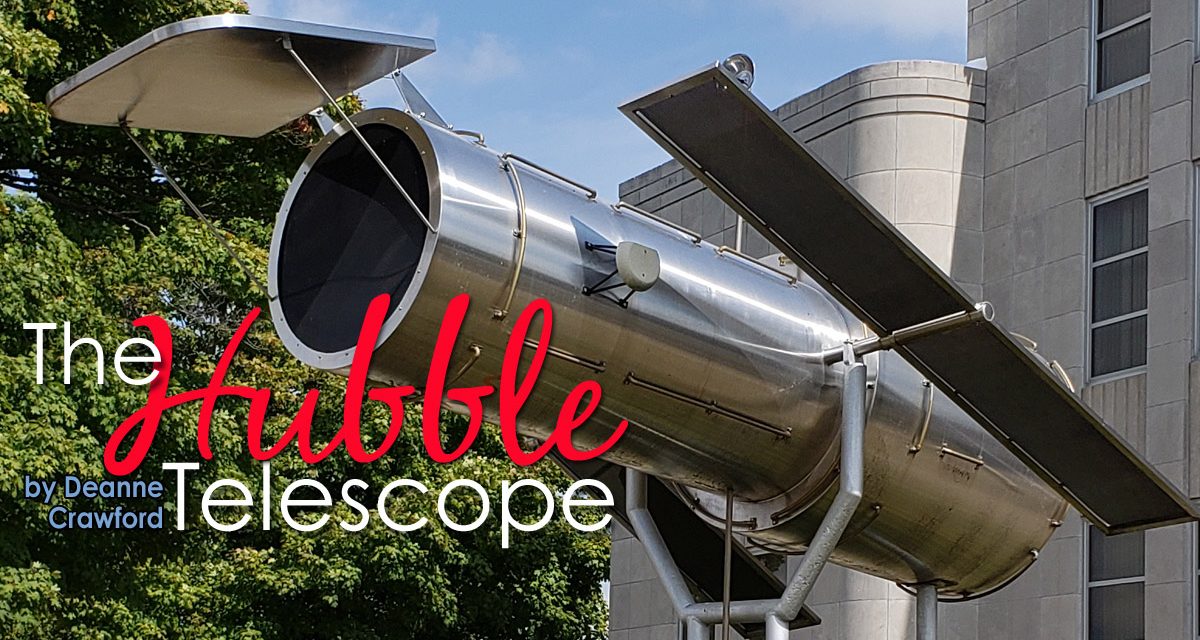Last month, my husband and I took a winding exploration down Route 66. Yes! The same route popularized by Disney® Pixar Cars. One of our trip’s highlights was visiting a replica Hubble Telescope in Marshfield, Mo, the birthplace of Edward Hubble, for whom the telescope is named. Standing in awe, I gazed up at the telescope and realized how much I didn’t know about this magnificent telescope. So, I did what countless other homeschool moms do, I decided to create a unit study! It is my hope that your family enjoys this introductory look at the Hubble Telescope!
Imagine for a moment, a large school bus stuffed with 2 elephants, moving systematically across the sky, a whopping 300 feet above your house. You watch as it passes over your roof and moves across your neighbor’s yard. Amazed, your mind fills with questions. What was that? How fast is it going? Where does it get its power? Questions swirl. Answers to these questions and others will be answered. If I miss your question, dig deeper and learn more about this powerful eye in the sky!
Weighing as much about 24,000 lbs. and measuring over 40 feet, the Hubble Space Telescope is the largest telescope in space (nearly the same as 2 elephants in a large school bus)! Orbiting approximately 356 miles above the earth, it the travels at 5 miles per second. Traveling at this speed, the Hubble makes one orbit around planet Earth every 95 minutes. Driving the family car at this speed, your family would be able to drive from the East Coast of the United States to the West Coast in 10 minutes! Comparatively, if you drove that car following all the posted speed limit signs, this same drive would take 4-6 days!
What does the Hubble telescope look like up close? Take a look at this 360-degree tour on the NASA website. Ask your children to describe or draw a Hubble Telescope. Set aside time to make a model Hubble Telescope using one of the 3 options here (PVC, paper or “expert”) or color the Hubble Telescope for your notebook using the template here.
What does the Hubble Telescope do 350 miles above the earth? It does pretty much what your backyard telescope does, only its view goes deeper into space and provides more details and colors. Scientists do not use their eyes to look through the Hubble telescope. Facing toward space, the telescope uses a digital camera to take pictures of planets, stars and galaxies. It has seen stars being born and stars die. It has seen galaxies trillions of miles away. Hubble also has seen pieces of a comet crash into the gases above Jupiter. The Hubble takes pictures of things that we are not able to see from Earth. On Earth, we are surrounded by atmosphere, which changes and blocks some of the light from space. The Hubble observes ultraviolet wavelengths, which the atmosphere filters out, and takes pictures of visible light to send to earth. These pictures are then sent back to Earth which scientists use to learn more about space. Learn more about how the Hubble Telescope works through Nat Geo Kids on YouTube®. YouTube® also offers an awe-inspiring montage of 600 images from the Hubble Telescope. You can also see a collection of images for each month on NASA’s Hubble site or just for fun, check out what the Hubble saw on your birthday!
How is this amazingly cool telescope powered? Traveling through space at 5 seconds per minute, observing light, and taking pictures plus sending them to Earth–whew! That must use a lot of electricity, right? Not only does it require electricity to move across the sky, all the instruments and computers on board the Hubble require electrical power. Surprisingly, NASA reports that on average the Hubble uses 2,100 watts of power, which is roughly the same as five refrigerators. Do you remember the 2 winglike panels on each side of the Hubble? Those large panels are not wings to fly the telescope, but instead are solar panels. Each winglike panel can convert the sun’s energy into 2,800 watts of electricity. Even when the Hubble is in the Earth’s shadow, there is enough energy stored in the onboard batteries to continue to travel and observe space for 7.5 hours (5 orbits around the earth)! This solar energy is stored in six batteries. To put this in perspective, these 6 batteries store an amount of power equal to about 20 car batteries. Learn more about solar power here.
How was this remarkable telescope named? Born in Marshfield, Missouri, in 1869, Edwin Hubble was fascinated with astronomy. Sadly, his father did not feel astronomy was a worthwhile field for his son. Submitting to his father’s wishes, Edwin put his enthusiasm for astronomy behind him and instead, pursued a degree in law. However, his passion for astronomy was too great, and he chose to return to his first love. Winning numerous awards for his discoveries, Edwin played a crucial role in studying and understanding objects outside the Milky Way Galaxy and is regarded as the leading astronomer of the 20th century. Learn more about Edwin Hubble here.
Progress is the goal of science and having an updated, more technologically advanced telescope has been a part of NASA’s vision since 1996. Working with the Canadian Space Agency and the European Space Agency, Hubble’s successor, the James Webb Space Telescope, has an estimated launch date of October, 2021. Learn more about their differences here. NASA offers a fun activity PDF to download about the Webb Telescope.
Thank you for joining me in this overview of the Hubble Telescope. As the mom whose child was fascinated by space, we regularly consulted NASA’s educational resources for our homeschool studies. I encourage you to visit their website for an amazing array of resources!
~ Deanne





